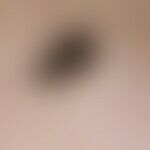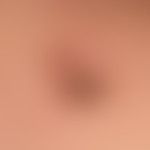Synonym(s)
HistoryThis section has been translated automatically.
DefinitionThis section has been translated automatically.
In actinically damaged skin, slowly growing (non-invasive) melanoma (in situ melanoma). This melanoma is a lesion of old age and occurs almost exclusively in sun-exposed areas (face, back of the hands, extensor sides of the forearms). The transition to an invasive growing lentigo-maligna melanoma is manifested by a palpable elevation. Histological clarification by staged sections and confirmation of the precise tumor stage (pTis = melanoma in situ, Clark level I) is mandatory.
You might also be interested in
Occurrence/EpidemiologyThis section has been translated automatically.
In a Danish study (2014), an increase in the "age-adjusted percentage change" incidence rate from 1997-2011 from 2.6 to 8.1 cases/100,000 for women and from 1.4 to 5.6/100,000 for men was demonstrated. These figures refer to both lentigo maligna and the precursor stage of SSM.
ManifestationThis section has been translated automatically.
Preferred population > 50 years. w > m
LocalizationThis section has been translated automatically.
ClinicThis section has been translated automatically.
Integument: Solitary, brown or blackish-brown, roundish-oval or bizarre, peripherally growing, (not palpable) inhomogeneous spot or patch of varying colour intensity; often with polycyclic or reticulated, sharp or blurred edges.
Reflected light microscopy: Highly irregular, prominent pigmentary net with breaks in the periphery.
Also visible are spots of diffuse pigmentation, central and peripheral black dots, possibly also irregularly limited depigmentation and a delicate grey cast.
HistologyThis section has been translated automatically.
Differential diagnosisThis section has been translated automatically.
- Verruca seborrhoica: Colour pattern may resemble the lentigo maligna. Mostly horn beads are detectable by reflected light microscopy. In case of doubt, a biopsy is decisive.
- Lentigo solaris: Less pigmented, homogeneous or inhomogeneous brown spot with mostly blurred edges. Transitions to lentigo maligna can be fluid.
- Melanoacanthoma: Deep black plaque not preferentially occurring in sunlight-exposed areas. Histological clarification.
- Pigmented basal cell carcinoma: Irregularly pigmented plaque; typical BCC criteria are usually detectable by incident light microscopy.
- pigmented Bowen's disease. Mostly sharply edged, irregularly configured plaque (no stain) with a rough surface.
TherapyThis section has been translated automatically.
Therapy of first choice is the (micrographically controlled) excision of the lesion with a (possible) safety margin of 0.5 cm. Here, a serial histological processing of the peripheral areas is an absolute prerequisite. The reported recurrence rates are between 0 and 6.25%. 85% of all dermatologists prefer excision as the method of choice in patients <60 years of age, 87% in patients between 60-70 years of age, 67% in patients > 70 years (Thio D et al. 2018).
Alternative cryosurgery: particularly indicated for larger foci in the facial area, whose surgery would result in a disfiguring scar. It may also be an option for patients of advanced age. The closed contact method with 2 cycles is recommended. In case of the open spray method a moulage has to be applied (25% of dermatologists use this method).
Alternative radiotherapy: especially indicated for patients > 70 years. Carried out with Dermopan (Siemens) or R.T. 100 (C. H. Müller, Hamburg) with a tube voltage up to 12 kV (borderline radiotherapy; GHWT 1.3 mm). Use 4-5 times 20 Gy in 2-day intervals (procedure is recommended by 27% of dermatologists).
Alternatively Imiquimod: currently widely used procedure (50% of all dermatologists use this therapeutic approach). In particular, the use of Imiquimod is indicated in patients > 70 years of age with significant limitations in operability. Local treatment with 5% Imiquimod cream (e.g. Aldara®) for 5-6 weeks (3 times/week, left for 12 hours). Recurrences or therapy failure were observed (27.5% residual lentigo maligna - results of a 5-year follow-up study; Kai AC et al. 2016). Furthermore, progressions with development of lentigo maligna melanoma were reported after completion of therapy.
Progression/forecastThis section has been translated automatically.
AftercareThis section has been translated automatically.
According to the malignant melanoma, initial control of the local findings every 3 months (period 1 year); later larger intervals. S.u. melanoma, malignant.
Case report(s)This section has been translated automatically.
LiteratureThis section has been translated automatically.
- Cognetta AB Jr et al (2001) Dermatoscopy of lentigo maligna. Dermatol Clin 19: 307-318
- Elsner Pet al (2014) Lentigo maligna and lentigo maligna melanoma as occupational skin diseases in a forestry worker with long-standing occupational UV exposure. J Dtsch Dermatol Ges 12:915-917
- Epstein E (2003) Extensive lentigo maligna clearing with topical imiquimod. Arch Dermatol 139: 944-945
- Farshad A et al (2002) A retrospective study of 150 patients with lentigo maligna and lentigo maligna melanoma and the efficacy of radiotherapy using border or soft X-rays. Br J Dermatol 146: 1042-1046
- Gambichler T et al (2014) Clinicopathological characteristics of 270 patients with lentigo maligna and lentigo maligna melanoma: data from a German skin cancer centre. Br J Dermatol 171:1605-1607
- Hutchinson J (1892) On senile moles and senile freckles and on their relationship to cancerous processes. Arch Surge 2: 218
- Kai AC et al (2016) Five-year recurrence rate of lentigo maligna after treatment with imiquimod. Br J Dermatol 174:165-168.
- Kroumpouzos G et al (2002) Lentigo maligna with spread onto oral mucosa. Arch Dermatol 138: 1216-1220
- Meseg A et al (2011) Imiquimod for the therapy of lentigo maligna. Act Dermatol 37: 182-183
- Rehberger et al (2006) Therapy of skin metastases in malignant melanoma. dermatologist 57: 1143-1153
- Tio D et al (2018) Variation in the diagnosis and clinical management of lentigo maligna acrossEurope
: a survey study among European Association of Dermatologists andVenereologists
members.J Eur Acad Dermatol Venereol 32:1476-1484. - Toender A et al (2014) Increased incidence of melanoma in situ in Denmark from 1997 to 2011: results from a nationwide population-based study. Melanoma Res 24:488-495
Incoming links (19)
Cryosurgery; Hutchinson\'s melanotic freckle; Imiquimod; Lead pigmentation of the oral mucosa; Lentigo maligna melanoma; Lentigo solaris; Melanoma desmoplastic; Melanoma in situ; Melanosis circumscripta dubreuilh; Melanosis circumscripta praeblastomatosa; ... Show allOutgoing links (11)
Basal cell carcinoma pigmented; Bowen's disease; Cryosurgery; Imiquimod; Keratosis seborrhoeic (overview); Lentigo maligna melanoma; Lentigo solaris; Melanoacanthoma; Melanoma cutaneous; Melanoma superficial spreading; ... Show allDisclaimer
Please ask your physician for a reliable diagnosis. This website is only meant as a reference.




























